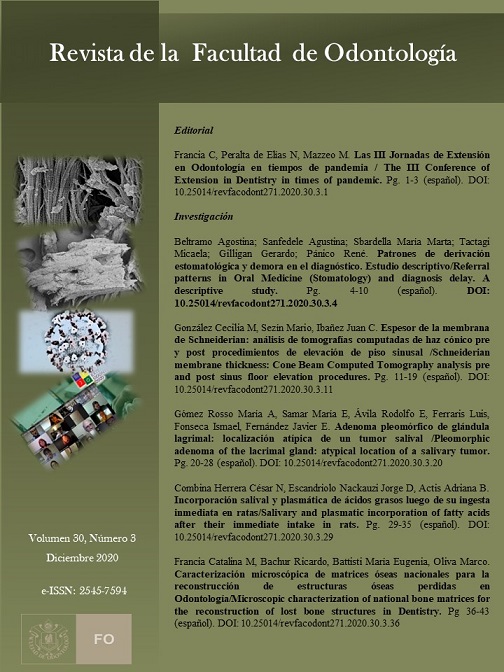Referral patterns in Oral Medicine (Stomatology) and diagnosis delay. A descriptive study
Keywords:
referral, early diagnosis, Stomatology, oral cancer and precancerAbstract
Objective: The aim of this study is to analyze and describe the referral patterns of two groups of patients who consulted the Oral Medicine Department “A”, FOUNC during the year 2019. Materials and methods: A retrospective descriptive study of analysis of clinical records of two groups of patients of the Oral Medicine Department “A” (2019). Four students, supervised by two professors, carried out the examination. There were registered the following variables: gender, age, type of referral (spontaneous demand, by students, by dentists, by other professionals), pre-referral treatments, evolution (from first symptoms at the time of the stomatological consultation), and kind of lesion (cancer / pre-cancer and other injuries) and prescription of biopsies. Results: 67 clinical records were registered. The average age was 49 years (48 years for men and 50 for women). The stomatological referral by dentists was the most frequent. In 56% of the registered clinical records, the patient consulted with inefficient previous treatments (without diagnosis) and in the remaining 44%, referrals were made without the prescription of previous treatments, noting a difference of 3 months in the average evolution of the lesions in both situations. 66% of the cases required biopsies. Discussion: When the referral is not appropriate, delays of oral lesions diagnosis are generated. Regarding these cases, the initial clinical scenario is modified, and therefore, the treatment and prognosis of the lesions. Practices must be carried out for postgraduate professional training in Oral Medicine, the promotion of early referral and awareness of self-medication risks.
References
1. Jitender S, Sarika G, Varada HR, Omprakash Y, Mohsin K. Screening for oral cancer. J Exp Ther Oncol. 2016 Nov;11(4):303–7.
2. Annertz K, Anderson H, Palmér K, Wennerberg J. The increase in incidence of cancer of the tongue in the Nordic countries continues into the twenty-first century. Acta Otolaryngol. 2012 May;132(5):552–7
3. Farthing PM, Speight PM. Educational aspects of oral cancer. British Dental Journal. 2018 Nov;225(9):875–8.
4. Farah CS, Simanovic B, Savage NW. Scope of practice, referral patterns and lesion occurrence of an oral medicine service in Australia. Oral Dis. 2008 May;14(4):367–75
5. Morelatto RA, Herrera MC, Fernández EN, Corball AG, López de Blanc SA. Diagnostic delay of oral squamous cell carcinoma in two diagnosis centers in Córdoba Argentina. J Oral Pathol Med. 2007 Aug;36(7):405–8.
6. Friesen R, McGaw T, Peters E, Lai H. A retrospective analysis of referral patterns to a university oral medicine clinic. Oral Surg Oral Med Oral Pathol Oral Radiol. 2019 Oct;128(4):381–5.
7. Kaing L, Manchella S, Love C, Nastri A, Wiesenfeld D. Referral patterns for oral squamous cell carcinoma in Australia: 20 years progress. Aust Dent J. 2016 Mar;61(1):29–34.
8. Sarumathi T, Saravanakumar B, Datta M, Nagarathnam T. Awareness and Knowledge of Common Oral Diseases Among Primary Care Physicians. J Clin Diagn Res. 2013 Apr;7(4):768–71.
9. Salonen L, Axell T, Helldén, L. Occurrence of oral mucosal lesions, the influence of tobacco habits and an estimate of treatment time in an adult Swedish population. J Oral Pathol Med. 1990 Apr 1;19(4):170–6.
10. Sardella A, Demarosi F, Lodi G, Canegallo L, Rimondini L, Carrassi A. Accuracy of referrals to a specialist oral medicine unit by general medical and dental practitioners and the educational implications. J Dent Educ. 2007 Apr;71(4):487–91.
11. Al-Amad SH, Ghebeh M, Saloum P, Maarouf TB, Moustafa YM, Younis Z. Pharmacists’ clinical competency towards oral mucosal diseases: Results from a mystery shopper study. Oral Dis. 2020 Jan;26(1):89–95.
12. Bawazir OA. Knowledge and Attitudes of Pharmacists Regarding Oral Healthcare and Oral Hygiene Products in Riyadh, Saudi Arabia. J Int Oral Health. 2014;6(6):10–3.
13. Taheri JB, Namazi Z, Azimi S, Mehdipour M, Behrovan R, Far KR. Knowledge of Oral Precancerous Lesions Considering Years Since Graduation Among Dentists in the Capital City of Iran: a Pathway to Early Oral Cancer Diagnosis and Referral? Asian Pac J Cancer Prev. 2018;19(8):2103–8.
14. van der Waal I. Are we able to reduce the mortality and morbidity of oral cancer; Some considerations. Med Oral Patol Oral Cir Bucal. 2013 Jan;18(1):e33–7.
15. Wade J, Smith H, Hankins M, Llewellyn C. Conducting oral examinations for cancer in general practice: what are the barriers? Fam Pract. 2010 Feb;27(1):77–84.
16. Akinyamoju AO, Adeyemi BF, Odofin AD, Balogun AO, Akinyamoju CA. Perception and utilization of oral histopathology services by general practice dentist in southwest Nigeria. Ann Ib Postgrad Med. 2017 Dec;15(2):103–8.
17. Murgod, Vinita, Angadi, PV, Hallikerimat, S. Attittudes of general dental practitioners towards biopsy procedures. J Clin Exp Dent. 3(5):418–23.
18. Piemonte, E, Brusa, M, Caciva, R, Panico, R. Errores cognitivos de diagnóstico en medicina bucal. Methodo. 2018;3(3):93–8.
Downloads
Published
Issue
Section
License

This work is licensed under a Creative Commons Attribution-NonCommercial-ShareAlike 4.0 International License.
Aquellos autores/as que tengan publicaciones con esta revista, aceptan los términos siguientes:
- Los autores/as conservarán sus derechos de autor y garantizarán a la revista el derecho de primera publicación de su obra, el cuál estará simultáneamente sujeto a la Licencia de reconocimiento de Creative Commons que permite a terceros:
- Compartir — copiar y redistribuir el material en cualquier medio o formato
- La licenciante no puede revocar estas libertades en tanto usted siga los términos de la licencia
- Los autores/as podrán adoptar otros acuerdos de licencia no exclusiva de distribución de la versión de la obra publicada (p. ej.: depositarla en un archivo telemático institucional o publicarla en un volumen monográfico) siempre que se indique la publicación inicial en esta revista.
- Se permite y recomienda a los autores/as difundir su obra a través de Internet (p. ej.: en archivos telemáticos institucionales o en su página web) después del su publicación en la revista, lo cual puede producir intercambios interesantes y aumentar las citas de la obra publicada. (Véase El efecto del acceso abierto).

